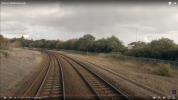-
Our booking engine at tickets.railforums.co.uk (powered by TrainSplit) helps support the running of the forum with every ticket purchase! Find out more and ask any questions/give us feedback in this thread!
You are using an out of date browser. It may not display this or other websites correctly.
You should upgrade or use an alternative browser.
You should upgrade or use an alternative browser.
Thornaby Items in the Four Foot
- Thread starter MOONY
- Start date
- Status
- Not open for further replies.
Sponsor Post - registered members do not see these adverts; click here to register, or click here to log in
R
RailUK Forums
3973EXL
Established Member
- Joined
- 2 Feb 2017
- Messages
- 2,447
Sleeper anchors to maintain track alignment on the curve.
swt_passenger
Veteran Member
- Joined
- 7 Apr 2010
- Messages
- 31,445
To add to the previous reply.
They work like a dagger board (keel) on a dinghy. What you don’t see is under the ballast in the middle of the sleeper there’s a couple of vertical steel plates, possibly a couple of square feet in total area, to keep the sleeper from moving sideways.
Pictures of a typical device in a Vossloh leaflet here:
They work like a dagger board (keel) on a dinghy. What you don’t see is under the ballast in the middle of the sleeper there’s a couple of vertical steel plates, possibly a couple of square feet in total area, to keep the sleeper from moving sideways.
Pictures of a typical device in a Vossloh leaflet here:
Last edited:
ASharpe
Member
Is it normally the cant that prevents lateral movement?
Would these just be a retrofit if movement was detected?
Or is it to do with thermal expansion or something else?
Would these just be a retrofit if movement was detected?
Or is it to do with thermal expansion or something else?
swt_passenger
Veteran Member
- Joined
- 7 Apr 2010
- Messages
- 31,445
I think they are a relatively new way of achieving the aim, but there were other means of doing so previously, typically there were “L shaped” plates screwed to the ends of the sleepers, but they were not so visible, so possibly not mentioned so much. These anchors possibly can be retrofitted if there’s a problem, but they are often fitted at renewal as well, presumably if curvature requires.
IIRC in a previous discussion it was explained that an advantage of the new anchors is that they can be slackened off before tamping, and then retightened afterwards.
IIRC in a previous discussion it was explained that an advantage of the new anchors is that they can be slackened off before tamping, and then retightened afterwards.
ac6000cw
Established Member
Is it normally the cant that prevents lateral movement?
As I understand it:
Cant is used to allow trains to go safely around curves faster, so (mostly) in effect it makes the problem worse as more centripetal force has to be applied by the track to make the train change direction (follow the curve) at the higher speed. The 'equal and opposite' force to that is what tries to make the track move laterally, which is resisted by the ballast and (if fitted) the anchors.
Think about swinging a ball-on-a-string around in a circle - the faster the rotation, the harder you have to pull on the string (apply more centripetal force) to stop it flying off at a tangent.
(Cant has the effect of translating some of the otherwise entirely lateral curving force into a vertical component, thus reducing the lateral force component for a given speed, so in theory there is some benefit from it in this context, but AFAIK it's mostly about increasing speeds and reducing railhead wear on curves).
- Status
- Not open for further replies.

